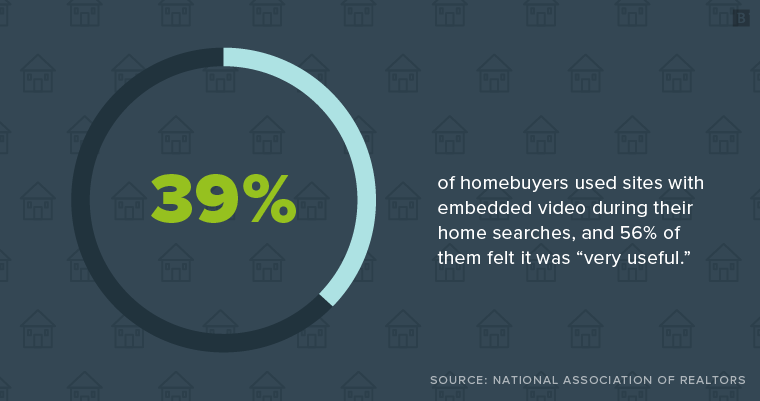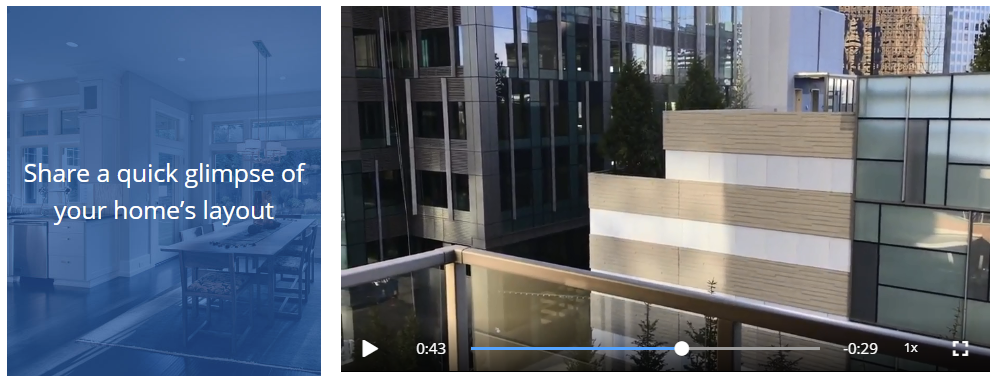Video may have killed the radio star, however, it’s been much better for real estate agents — many of whom have used video marketing to transform their practices for the better.
A well-made real estate video — whether a virtual tour shot by phone or aerial footage captured by drone — can be an invaluable resource for both buyers and sellers. If one picture is worth 1,000 words, then one frame (or one second) of video is worth 30,000. Video showcases a property in much more detail than almost any other medium.

(I say this as someone whose own house still exists in online property databases mostly as low-res, outdated photos — the real estate equivalent of grainy Big Foot footage).
Why Real Estate Video Marketing Is So Important
Beyond video itself being a highly effective marketing strategy across industries that drives SEO and engagement from prospective buyers, it’s integral for real estate agents who want to attract more sellers, too.
73% of homeowners say they’re more likely to list with a realtor that uses video, which is why it’s strange that only about 10% of agents take advantage of a video strategy today, according to a report from the National Association of Realtors (NAR).
But from a sales standpoint, here are a handful of reasons why real estate video is paramount in today’s market:
Subscribe to
The Content Marketer
Get weekly insights, advice and opinions about all things digital marketing.
Thank you for subscribing to The Content Marketer!
Reliable Lead Generation and Nurture
How do real estate agents get people to look at their property listings? Video marketing is one of the effective ways, since it works at all parts of the sales funnel:
- At the top of the funnel, it can generate valuable page views and boost SEO. Links to pages with embedded YouTube videos get exponentially more organic search results than ones without it.
- Near the middle and bottom of the funnel, a compelling video can be the last nudge buyers need to make a call or send an email to a real estate agent or the property owner.
- Sharply produced video can also persuade sellers to work with an agent, confident that their property will be shown in the best possible light.
- Overall, property listings with video generate more leads.
Consider this cinematic 4K real estate video that gives viewers a great sense of the location, design, features and functionality of a custom-built home.
This video works as well for someone who has never seen the property before as it does for a serious buyer hoping to get just a little more insight into the interior and what it would be like to actually live there.
Versatile Use Cases: Tours, Testimonials and More
A house or apartment showcase is just one possible use case for property videos. A real estate video might also be used for:
- In-depth guided tours of each room of a residence, perhaps using AR or VR tech (although be careful here, so that the video doesn’t mislead the viewer).
- Customer testimonials from buyers and sellers about their experiences with a real estate agent.
- Pre-property listings, in which agents introduce themselves and their methods, perhaps while also highlighting the importance of choosing the right agent (them).
This video targeted at home buyers is a great example of the last point. It’s a brief, sub-50 second video wherein the agent introduces themself to buyers. Then, they give a brief career history and talk about why buyers should choose them before it wraps up with a skit between them and a client.
Unique and Immersive Perspectives
We mentioned AR and VR above, and they both illustrate the advantages of video in real estate marketing — but they aren’t the only type of video that offers a unique perspective.
Aerial footage in particular also stands out, as it’s both fun to watch and uniquely informative. More specifically, it can provide a sharp look at a property beyond the standard street-level perspective.
This video of a luxury home in Alaska combines aerial drone footage of the property and neighborhood with an interior “fly-through” of the abode. The combination of the interior and drone exterior shots give viewers and prospective buyers a great sense of the location.
How to Produce and Share a Real Estate Video
One of the first questions to answer when thinking about real estate video is whether to create and distribute them yourself or enlist the help of professional videographers and social media experts. Either approach — let’s call them DIY video and professional video production — can work, but it’s important to know what you’re getting into beforehand.
DIY Video
Just like it sounds: You shoot and edit videos yourself or in-house.
Advantages:
- Complete editorial control over the video production.
- Can be done using a simple DSLR camera or phone much of the time (plus a drone for the aerial footage).
- Relatively cost-effective compared to hiring a team of pros.
Disadvantages:
- Can be challenging to get the right angles and quality.
- Can become time-consuming, with a lot of trial and error.
- Overall requires considerable technical skill and digital media savvy.
There are numerous how-to DIY videos on YouTube and elsewhere. They generally offer a step-by-step look into how you can put together a polished property video using your own equipment. And while it’s certainly doable, many complications can arise.
For starters, you will almost certainly need wide-angle lenses and stabilizers if you’re using a DSLR, not to mention a high-quality and well-placed microphone. Without them, you run the risk of unfocused and shaky videos that look low-quality to viewers, potentially scaring them off.
Editing is also crucial. For example, you’ll typically want to edit videos that showcase a house such that they mirror the sequence of a real-life tour. Ultimately, it takes a lot of effort to get a DIY video right unless you’re already well-versed in the relevant tools and technologies.
Professional Video Production Or Premade Video
Professional and premade videos are actually two different types, united by the fact that they’re produced by third parties instead of internally. Professional video encompasses any type of video work from dedicated videographers who will capture and edit footage to your specifications.
Premade video is a bit different. Some services, such as Promo, offer stock clips that can be customized and incorporated into real estate videos, especially one designed for social media. To that end, Promo makes it easy to get the right aspect ratio for different social media platforms (e.g., widescreen for YouTube, square for Instagram, etc.). Others like Animoto provide a drag-and-drop video maker for easily turning your own footage into a video.
Advantages:
- Done by experienced professionals.
- Less time-consuming than DIY video.
- Highly customizable for different use cases.
Disadvantages:
- Not as much control over video content.
- Can be expensive.
- Stock footage might not be as compelling as original content.
Where Should Real Estate Videos Be Posted?
Property videos are frequently incorporated into multi-channel marketing strategies. Two of the most common channels are:
Social Media
Real estate professionals are ubiquitous on social networks like Instagram and YouTube. We shared some YouTube clips above, so let’s look at one from Instagram here to get a feel for how a video on that platform might look.
This one, showcasing a condo in Orange County, uses aerial footage to open and then proceeds to a guided tour. The backing music track is innocuous yet soothing, and the camerawork is very steady. The closing aerial shots then show the condo’s position relative to other locations in the neighborhood. Finally, the caption includes contact info, plus lots of hashtags for high search visibility.
View this post on Instagram
Real Estate Websites
If you’ve ever looked up a property online, chances are you’ve gone to either Zillow or Realtor.com. Both of these sites allow listers to embed videos and virtual tours to give viewers a better sense of the property and help with real estate marketing.
For instance, here’s a still from a sample Zillow video. Sellers and relators can quickly create these videos using Zillow’s mobile app.

View Zillow’s video examples here.
How Long Should Your Real Estate Video Be?
Video length really depends on what type of content you’re making. However, one rule of thumb is that most real estate videos should be between 3 and 7 minutes in order to hold viewers’ attention. Optimal length will also vary based on any restrictions from the site or social media platform in question.
Types of Real Estate Video Content (With Examples)
Like cinema, real estate video has a set of distinctive genres. Instead of the documentary or the drama, though, there are go-to types such as the guided tour and customer testimonial. Let’s look at some of the major formats and what each one entails, along with a real example.
Listing Video
What it is: A video designed to accompany a specific property listing.
What it should include at a minimum: An overview of the property, including a look at (or guided tour of) its rooms and any relevant features, in addition to info like the address, size and agent contact details.
Relevant enhancements to consider: Aerial footage, textual overlays (e.g., to quickly convey the information above), background music, narration, neighborhood markers, stock footage, AR/VR (for tours mostly).
This luxury real estate clip checks all the boxes for a good listing video. In a little over two minutes, it shows off the property’s interior and exterior, with plenty of shots of a family actually using it. Aerial footage provides nice framing, and all the relevant contact info is at the end. It’s also a great pitch to sellers looking to have their luxury properties properly presented.
Testimonial Video
What it is: A video featuring testimonials from, or interviews with, a real estate agent’s previous buyers and sellers, local businesspeople, or other individuals of interest such as mortgage lenders.
What it should include at a minimum: A well-edited, relevant testimonial that seems genuine and positive.
Relevant enhancements to consider: Q&A sessions, background music, interior and aerial footage of the property bought/sold.
In this testimonial, a young couple shares their experience as first time home buyers with their realtor, Mandy Saldana. It’s a short and simple sit-down style clip with lively music where, in just over a minute, viewers will likely form a positive opinion about the realtor in question.
Advice Video
What it is: A video of a real estate agent offering guidance to buyers and sellers on how to navigate real estate transactions.
What it should include at a minimum: Answers to commonly asked questions and solutions to various problems.
Relevant enhancements to consider: Graphics, viewer-submitted questions.
Buying or selling a home is a complex process. There are numerous possible complications related to which mortgage lender to use, when to sell and how to make a standout offer. In this Realtor.com video, the viewer watches on as experienced real estate industry professionals who belong to an authoritative real estate company discuss tips and advice for first-time buyers.
Getting Real About Real Estate Video
Buying or selling a residence is a high-stakes process. But with the advantage of sharply crafted video showcasing the property, these transactions can be made much easier.
As you make and share your real estate videos, don’t be afraid to go beyond the examples included here. Creative video making, whether DIY or from a professional team, can be decisive in landing a key client. For more ideas on how to incorporate video in your overall real estate marketing strategy, you can check out our longform guide on that subject.
Editor’s Note: Updated April 2023.





